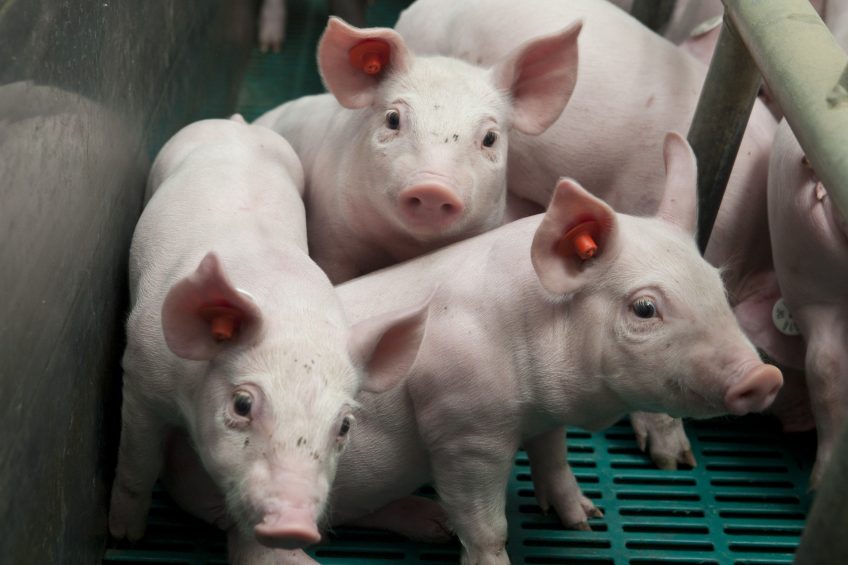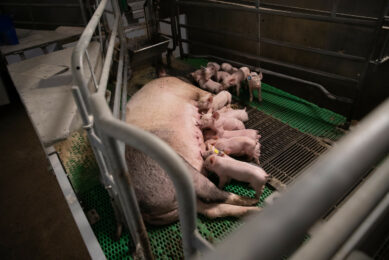An isotonic drink for pigs – what is it?

Did something good ever come from the 2014 PEDv outbreak in North America? Well, definitely yes – one of the things that was discovered are ways to help pigs and piglets in times they need it most. An ‘isotonic drink’ is one of them.
It’s not that often that ‘enterocytes’ are the key focus of an article in Pig Progress. Small as they are, these gut cells play an important role for the growth and well-being of pigs and piglets. They are essential in the absorption of proteins, carbohydrates and fats so the animals can build new cells and tissues.
Enterocytes are epithelial cells that line the villi of the small intestine. As such, they are the entry points along the small intestine that readily absorb amino acids, simple sugars and fatty acids before they are transferred into the bloodstream.
Enterocytes can absorb many nutrients simultaneously, but can only manage them in small sizes. In reality, only single sugar molecules or groups of two or three amino acids can enter the enterocyte; single amino acids are preferred. Once ingested, these nutrients are then transported to the bloodstream where they are distributed to the rest of the body and re-assembled into proteins or carbohydrates to be used.
All nutrients have to come in through the ‘front door’ of the enterocyte, move through the cell, and go out the ‘back door’ again into the bloodstream, where they circulate and can be used by the body’s tissues. The ‘doors’ can only open and close with the assistance of sodium and potassium. The ‘doors’ also require energy to open and close, meaning that the enterocytes have special nutrient requirements of their own.
Formulating nutritional solutions
One would think that these enterocyte functions are kept in mind when formulating nutritional materials for pigs and piglets, but that doesn’t always appear to be the case. Take for instance simple salt-and-sugar solutions which have been used to treat dehydration and reverse the effects of diarrhoea. These solutions provide the necessary oral rehydration therapy; however, simple salt-and-sugar solutions do not particularly feed the enterocytes.
Singularly feeding enterocytes
Tonisity International developed a method of singularly feeding these enterocytes, by providing an isotonic protein solution containing the right balance of amino acids and sugar molecules. Their flagship product ‘Tonisity Px’ is available for pigs from all ages, as from day 2 of age.
Key to this strategy is the word ‘isotonic’, meaning that the fluid that contains the same amount of water and total solutes as the body’s cells. Isotonic fluids in the small intestine have been shown to be the most effective concentration for rehydrating the body. They can be readily absorbed without creating further losses of sodium or water. Every fluid that is used for intravenous fluid therapy is also isotonic.
As an isotonic protein solution, the drink also provides the necessary fuel sources for these enterocytes. That is where ‘micro-enteral nutrition’ comes in, delivering nutrients specifically to nourish the enterocyte cells in the small intestine. Pigs of every age enjoy drinking it because the product is created to be sweet and sour, making it particularly appealing to young piglets. That way, the approach has the potential to unlock piglets’ appetite whilst increasing their weaning weights and preventing pre-weaning mortality. In addition, ongoing trial data supports the long-term use of this isotonic strategy, linked to reduced stress, an evident improvement in intestinal health and a reduction in antibiotic requirements.
Figure 1 – Na+ and K+ pumps in the enterocytes for nutrient absorption.

Origins of the concept
The idea was born out of Dr Ava Firth’s work as a specialist in veterinary emergency and critical care, treating dogs and cats. In 2011, she worked with Dr Simon van Dalsem and Mackle pet foods to develop an isotonic drink for critically ill dogs and cats, to support their nutritional requirements in illness. She used this drink with good success in many categories of patients, especially dogs with parvovirus, which is a serious illness characterised by haemorrhagic diarrhoea.
In 2014, when the PEDv outbreak developed in the USA, the parallel between canine parvovirus and swine PEDv became apparent and the three of them, with the support of Alon Rosenberg, worked to develop a formula that would be useful in pigs. In early 2015, the company Tonisity was formed to commercialise the product.
How is it absorbed?
Research carried out by Tests & Trials of Monzon, Spain over the past three years has specifically looked into the impact of the enterocyte strategy on intestinal health with substantial evidence proving that an isotonic protein drink can lead to heightened villi during the first few weeks of a piglet’s life. Similarly in the post-weaning phase, the villi were taller by nearly 16% in the isotonic drink group with an average villi height of 291 µm compared to 249 µm in the control group. These developments in villi height and intestinal health demonstrate that the application of an isotonic drink can be linked to heightened villi and as a result, improved nutrient absorption into the bloodstream.
Pre-weaning mortality and piglet weights
Two independent university trials were carried out in Poland and Croatia, as well as various large-scale studies by individual producers according to a protocol, all to determine the effects of the isotonic drink. This way, over a period of six months, it was possible to get the isotonic drink tested across several farms in six countries (Croatia, France, Italy, Poland, Romania and Ukraine).
In one study, involving 497 litters and 6,987 piglets, sows and their litters were allocated to either a isotonic drink trial group or a control group. It was found that pre-weaning mortality was lower in the isotonic drink group (10.81%) compared to the control group (13.78%). Overall, the mortality was reduced by an average of 21.55% in the isotonic drink group.
The isotonic drink was also tested on 382 litters and 5,275 piglets with regards to its effect on weaning weight when given to piglets from day 2-8. At weaning, after almost 26 days, piglet weights were higher in the group receiving the isotonic drink (7.07 kg) compared to the control group (6.71 kg). This was an increase of nearly 360 g or 5.37%.
Post-weaning weight
Studies were also carried out on post-weaning weight across several European countries. Taking Ukraine as one country-specific example, the live weights of piglets were recorded across both the ‘isotonic drink’ group and the control group. It was found that from days 28-75 of the post-weaning period, the ‘isotonic drink’ group outperformed the control group in terms of weight gain (see Table 1).
Results like these prove the effectiveness of the isotonic drink in the post-weaning period with a 5.04% increase in live weight by day 75 in the isotonic drink group compared to the control group.











